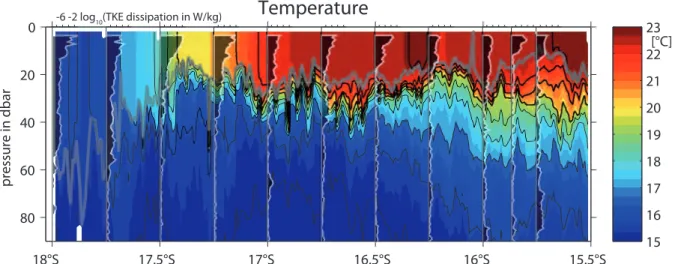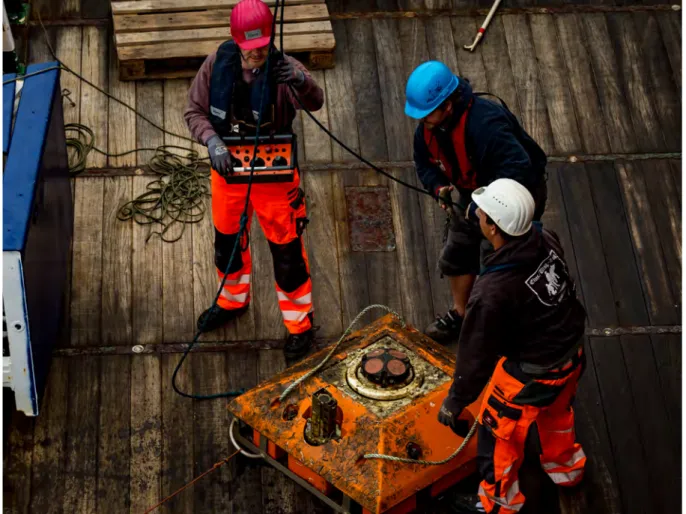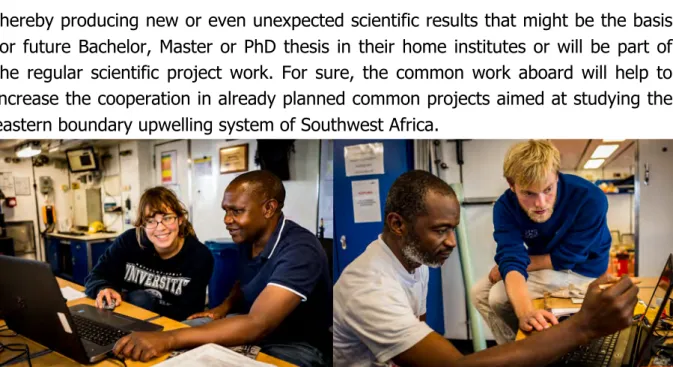Prof. Dr. Peter Brandt Meteor-Reise 131
5
thWeekly Report M131, Recife-Walvis Bay
07.10.-12.11.2016
During the fifth week of METEOR cruise M131, we sailed from the tropical ocean off Angola toward the markedly cooler and rougher areas off Namibia. On the way southward, we cut through the so-called Angola-Benguela frontal zone (ABFZ) located at about 17°S just at the border between the exclusive economic zones of Angola and Namibia. Near the front, the water temperature drops within a few miles from about 22°C north to 16°C south of the front. The correct simulation of the ABFZ is still a challenge for coupled climate models. A misrepresentation of the location of the front results in large errors in the simulated sea surface temperature with consequences for the simulated climate of the tropical Atlantic as well as globally. An important aspect defining the location of the front is the forcing by along-shore winds. However, oceanic processes, like the advection of water mass anomalies, the rising and deepening of the oceanic thermocline associated with propagation of coastally trapped waves with periods of months to years, or the vertical mixing and associated downward heat transport, might play an important role as well.
After finishing the CTD and microstructure program along 15°S, still north of the front, we started high-resolution measurements across the ABFZ with the Underway CTD. The RapidCast system delivered by Teledyne Oceanscience is capable to acquire temperature and salinity profiles at full ship speed down to about 120m depth with a temporal resolution of 4 to 5 minutes resulting in a spatial resolution of about 1.5 km. The gained dataset nicely show the dramatic temperature decrease from north to south as well as the strong, episodic deepenings of the oceanic mixed layer south of the front (Fig. 1).
Fig. 1: Temperature in the upper ocean as measured with the Rapid Cast system (color scale). The thick grey line marks the mixed layer depth. Vertical mixing profiles (grey shaded) are superimposed at the measurement position with the scale given in the upper x-axis (Figure: Sören Thomsen).
pressure in dbar
Temperature
18°S 17.5°S 17°S 16.5°S 16°S 15.5°S
0 20 40 60
80
15 16 17 18 19 20 21 22
-6 -2 log10(TKE dissipation in W/kg) 23
[°C]
Prof. Dr. Peter Brandt Meteor-Reise 131
The following program of M131 includes hydrographic cross-shelf sections off Namibia at 18°S, 20°S and 23°S. Besides CTD and microstructure measurements as well as sediment grab and dredge sampling, we serviced several moorings on these sections. Up to now, we were able to successfully recover the IOW bottom shields at the shelf at 18°S and 20°S (Fig. 2). The mooring work of our cruise will be accomplished shortly before reaching Walvis Bay, the final destination of METEOR cruise M131. The moorings on the shelf off Namibia are, amongst others, equipped with acoustic Doppler current profilers. These instruments measure time series of the full-depth velocity, thereby allowing to follow signals in the along-shore flow that might propagate along the southwest African coast from the equator as far south as Walvis Bay. Associated changes in water mass properties, like temperature, nutrients and/or oxygen directly affect the biological productivity in the eastern boundary upwelling region.
Fig. 2: Successful recovery of the IOW bottom shield equipped with an ADCP on the shelf off Namibia at 18°S (photo: SvN).
Besides our ongoing measurement program, the already acquired data are directly analysed by the students and scientists aboard. Particularly, the working groups established at the beginning of the cruise made good progress, which was reported regularly during our seminar series. The cooperation between German scientists and students and their African colleagues was very intense throughout the cruise (Fig. 3)
Prof. Dr. Peter Brandt Meteor-Reise 131
thereby producing new or even unexpected scientific results that might be the basis for future Bachelor, Master or PhD thesis in their home institutes or will be part of the regular scientific project work. For sure, the common work aboard will help to increase the cooperation in already planned common projects aimed at studying the eastern boundary upwelling system of Southwest Africa.
Fig. 3: Good cooperation within the working groups during common data analysis. From left: Thea Hamm, Enoque Vasco, Paulo Coelho, Eike Koehn (photos: SvN).
Here some statements regarding our cooperation on board:
„I am impressed by the long-term datasets of our colleagues from Angola and Namibia. They represent important measurements over a long period in time that will help to understand long-term changes in the coastal upwelling regions off Southwest Africa. Up to now, I hadn’t the possibility to work with the data and it was particularly interesting for me the get a first impression of the data available in our partner institutes“, says Josefine Herrford, 27 years old. As PhD student at GEOMAR she studies water masses and large-scale circulation in the South Atlantic.
Long-term cooperation and an emancipated exchange at eye level are crucial when working together, opines Sören Thomsen, 30 years old and PostDoc at GEOMAR. The topic of his research is “small-scale temperature fronts in upwelling areas”. The cruise with METEOR brought new insight in different aspects of the study area.
„However, 5 weeks on the ship or 3 years of a project are not enough to understand the relevant processes in this region of the World Ocean. In Angola and Namibia, scientists go at sea every day partly since more than 30 years to measure different parameters of their ocean. Such long-term observations are crucial to address climate variability and change; this is another reason for the importance of a long- term engagement and cooperation.“
For Hannah Wiese, 25 years old, Master student in „Climate Physics“, it is the first cruise with METEOR: „I had to learn the sequence of operations and the work on board the same way as my colleagues from Angola, Namibia and South Africa. I wouldn’t forego the group work or the common watches for example at the CTD stations and the Underway CTD. Together, we have analysed data accompanied by interesting discussions. I think, it would be great, if this cooperation could be
Prof. Dr. Peter Brandt Meteor cruise 131
intensified, for example during summer schools or with the exchange of scientists and students. I would like to work for few months at one of the partner institutes in Africa and, of course, I would be happy, if students from the African countries we cooperate with, would visit us at our institute in Kiel. “
Besides our full working program until the last day of the cruise, packing of instrumentation and equipment has already started. METEOR will arrive in Walvis Bay on November 12. There, we will meet the new chief scientist and part of her crew to discuss the usage of different instrumentation that was used during our cruise and will be used during the following one. So, we look back to a very intense and successful research cruise with very good, harmonic and joyful mood. I would like to personally thank the whole scientific crew for their work during the cruise and, of course, we would like to thank captain Rainer Hammacher and his crew for the excellent working environment, the friendly atmosphere, and last but not least the great hospitality. At the end, just a few words about our guest aboard: Stephanie von Neuhoff. She works as freelance journalist and author. During our cruise, she intensively looked at the cooperation between Germany and Africa at different levels reaching from the scientific, political and institutional to the personal level within the cooperation between students and scientist during the daily work aboard METEOR.
The results of her work include many fascinating photos, text contributions for our public relations and, of course, ideas and thoughts emerging from many discussion about our work and our motivation. The material produced aboard will be used in different projects of her that will be continued commonly beyond the cruise. As an example, the International Maritime Museum Hamburg will show a selection of photos taken during the cruise in a large-sized projection in the frame of the „30 Years Meteor-Celebration“ and present an exhibition of the history of METEOR.
Greetings from the tropics,
Peter Brandt and the cruise participants of M131


